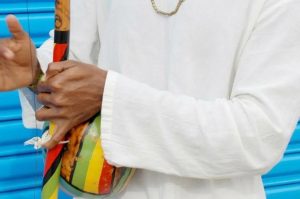To the haunting sound of Berimbal, novice capoeiristas from Los Angeles, San Francisco, San Diego, Santa Barbara, New York, Paris, Tel Aviv, Tokyo, Sidney, among other cities, fellow their teacher, swaying from side to side… it is the “Ginga” that have enchanted the world is the Brazilian art from that became the coolest dance and fitness trend in many cities of U.S, Europe, Asia, Oceania and Latin America.
The berimbal is a single-string percussion instrument, a musical bow, from Brazil, but originally from Africa where it receives different names. It was eventually incorporated into the practice of capoeira (Afro-Brazilian martial art) and leads the capoeiristas (players) movement in the roda. Usually, the faster the berimbau is playing the faster the capoeirista moves in the game. The berimbau slowly came to replace the drum as the central instrument for the “jogo de capoeira” (capoeira game), which it is now famous for and widely associated with.
The berimbau consists of a wooden bow (verga), traditionally made from Biriba wood, which grows in Brazil and usually between about 4 to 5 feet long, with a steel string (arame) tightly strung and secured from one end of the verga to the other. A gourd (cabaça), dried, opened and hollowed-out, attached to the lower portion of the Verga by a loop of tough string, acts as a resonator.
To play the berimbau, one holds it in one hand, wrapping the two middle fingers around the verga, and placing the little finger under the cabaça’s string loop (the “anel”), and balancing the weight there. A small stone or coin (pedra or dobrão) is held between the index and thumb of the same hand that holds the berimbau. The cabaça is rested against the abdomen. In the other hand, one holds a stick and a shaker (caxixi). One strikes the arame with the baqueta to produce the sound. The caxixi accompanies the baqueta. The dobrão is moved back and forth from the arame to change the pitch produced by the berimbau. The sound can also be altered by moving the cabaça back and forth from the abdomen, producing a wah-like sound.
 How much do you pay for a berimbal in the U.S.?
How much do you pay for a berimbal in the U.S.?
The average prices in America is around $60, but be bcareful where you buy it because they can range from $30-$120 (prices ranges based in 2017). You could end up getting some cheap wood like “araçá”, which will break easily and the sound is not the best one for sure. By preference, try to buy it “live” – avoid purchase it online or make sure that you got it in “Biriba” wood.
Capoeira Unveil Brazil’s Afro Roots
Somos todos juntos uma miscigenação
E não podemos fugir da nossa etnia
Índios, brancos, negros e mestiços
Nada de errado em seus princípios
O seu e o meu são iguais
Corre nas veias sem parar
Costumes, é folclore é tradição
Capoeira que rasga o chão
Samba que sai da favela acabada
É hip hop na minha embolada
É o povo na arte
É arte no povo
E não o povo na arte
De quem faz arte com o povo
Por de trás de algo que se esconde
Há sempre uma grande mina de conhecimentos
e sentimentos
Não há mistérios em descobrir
O que você tem e o que gosta
Não há mistérios em descobrir
O que você é e o que você faz
Maracatu psicodélico
Capoeira da Pesada
Bumba meu rádio
Berimbau elétrico
Frevo, Samba e Cores
Cores unidas e alegria
Nada de errado em nossa etnia.
*Music “Etnia” from Chico Science & Nação Zumbi


